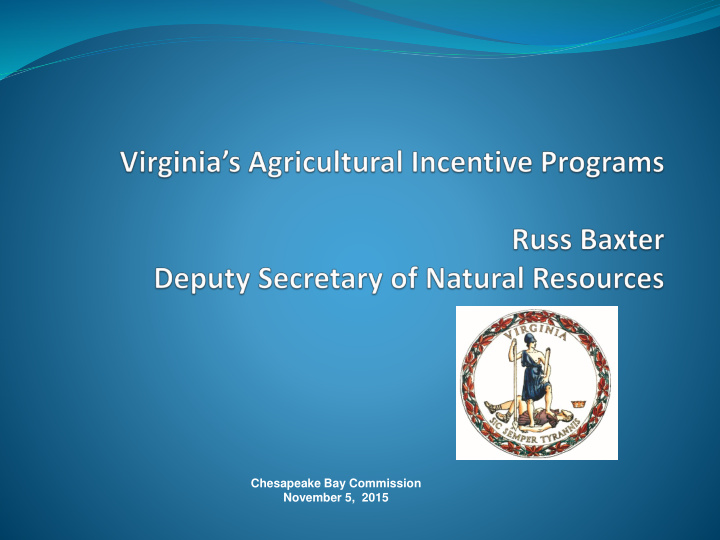



Chesapeake Bay Commission November 5, 2015
Virginia Agricultural Cost-Share Program 41 practices eligible for cost-share: standards and specs defined in the Virginia Cost Share Manual In recent years, total expenditures range between $20M - $25M/year (amounts available variable depending on year end surplus, competition with other water quality needs and amount of recordation fees collected) Overseen by the Department of Conservation and Recreation in partnership with our 47 Soil and Water Conservation Districts Average state share is 75% for cost/shared practices Some practices are funded at a flat rate (e.g. cover crops $ per acre) Money dispersed to SWCDs for practices are accompanied with financial support to administer and provide technical assistance
“TOP 5” Cost Share Practices State Funds Expended from FY12-15 by BMP Category Funding BMP Category Total State Funding Number of BMPs Rank 1 Stream Exclusion (all BMP types) $47,834,127 2526 2 Cover Crop $24,920,464 20940 3 Nutrient Management $5,400,421 32491 4 High Residue Tillage Mgt (no-till) $4,342,374 1368 5 Animal Waste $3,990,176 204
Tax Credits
Conservation Tax Credits • VA income tax credit = 25% of participant's expenditure • Available for 58 agricultural practices (cost-share practices + tax credit only practices.) • $17,500 maximum per tax year for BMPs • Tax Credits also available for certain types of equipment - $4,000 cap on no-till equipment - $3,750 cap for precision ag equipment Requires soil conservation plan for BMPs Requires a nutrient management plan for precision ag
Livestock Stream Exclusion Incentives 100% guarantee began in late 2012 Sign-up before June 30, 2015 Only for SL-6 practice No expiration on state guarantee of funding Must sign contract within 90 days of offer of funds Sign up after June 30, 2015 – three options State cost share alone – 80% w/$70K cap 100% + w/USDA-CREP if plant buffer RCPP - $1.45 million w/state match through Sept ’17 (available to producers from NRCS)
Livestock Stream Exclusion “SL - 6” Practice Minimum 10 year exclusion fence Minimum 35 foot vegetated buffer* Alternative watering systems (troughs) Hardened stream crossings Pasture (grazing) management* Fences protect the buffers and streams Stream crossings, troughs, and cross fencing assist with herd management
Sign Up for Livestock Stream Exclusion More farmers signed up for first time for a cost-share program >2,900 total SL-6 applications ( incl. ~ 1,600 in Chesapeake Bay @$64M) Benefits statewide of SL-6 initiative 9.9M feet of stream protected 131,000 animal units excluded
Status of Livestock Stream Exclusion Approved (expended/obligated) $53.5M ~1,600 SL-6 BMPs statewide ChesBay $30.5M Includes $1.7M from Bay Grants Outside ChesBay/So. Rivers $23M Benefits in Chesapeake Bay from $30.5M ~2.5M linear feet of stream bank protected ~30,000 animal units excluded
Status of Livestock Stream Exclusion Backlog (Pending) SL-6 sign up - $68M ~1,300 still need funding statewide Chesapeake Bay <$34M (~670) Outside ChesBay/So. Rivers >$34M (~630) Additional benefits to Chesapeake Bay 3.2M more feet of stream bank protected 42,000 more animal units excluded
Reductions from SL-6 Initiative Estimated 2025 WIP benefit of $64M of SL-6 in Chesapeake Bay Close 34% of the Nitrogen gap for ag. Close 13.6% of the Sediment gap Plus considerable bacteria reductions to help many local TMDLs (bacteria is still number one impairment in local water bodies)
Resource Management Plans Program established by bill proposed by ag interests passed in the 2011 session of the General Assembly Implementing regs prepared by DCR and adopted by Soil and Water Conservation Board RMPs encourage farmers to use a high level of conservation best management practices to reduce nutrient and sediment runoff by offering a “safe harbor” (or certainty) from any new state requirements, except VPDES permits or requirements under the state Chesapeake Bay Preservation Act. Certainty is effective for nine years . Compliance inspections every three years. A farmer may withdraw at any time.
Resource Management Plan Features Livestock stream exclusion fence 35 foot vegetated buffer for cropland and hayland Soil loss reduced to “tolerance” or “T” Nutrient Management Plan BMP schedule tailored to an individual farm SWCDs administer and ensure compliance DCR reviews SWCD RMP programs
Resource Management Plan Progress Original goal of 40 RMPs by Dec ’15 Revised goal 274 RMPs/47K acres in Ches Bay Already 280 RMPs/47K acres all Ches Bay SWCDs review then implementation follows 2016 contracts for both Chesapeake Bay and Southern Rivers
Assistance for Small Dairies
Assistance for Small Dairies 2 Staff hired through contract with Virginia Tech Development of Outreach Materials Working with industry reps on outreach Currently developing plans for 2016 for outreach and nutrient management plan development.
Land Preservation Tax Credit Virginia Income Tax Credit for 40% of value of donated land or easement Owner may use up to $20,000 per year in 2015 and 2016 and $50,000 in subsequent years Credits can be carried forward for up to 13 years Unused credits may be sold
Farmland Conservation Land Conservation Tax Credit available for ag. lands. For credits over $1 million, ag. lands must meet specific conservation requirements and have buffers, livestock exclusion, conservation plans (nutrient management)., cover crops, stabilize erodible lands). Office of Farmland Preservation worked with local PDR programs to permanently preserve 1,256 acres of working farm and forest land
Farmland Conservation In 2013, about 18,835 acres of lands conserved under the tax credit were in agricultural use of a total 60,948 acres. To be eligible, easement must qualify as a charitable deduction under the IRS Code and Virginia law. Forest land also has conservation requirements and water quality protection requirements.
Policy Issues Transitioning from cost-share for practices that have become common practice – (Current contract with VA Tech to evaluate conservation tillage) What influence will nutrient credit generation on agricultural lands and the requirements for “baseline” practices have on BMPs Ensuring that technical assistance is available (SWCD) Using GIS and other technology to achieve greater efficiency and better results.
Resources Resource Management Plans http://www.dcr.virginia.gov/soil-and-water/rmp Cost Share Program Homepage http://www.dcr.virginia.gov/soil-and-water/costshar Cost Share Manual http://dswcapps.dcr.virginia.gov/htdocs/agbmpman/agbmptoc.htm Nutrient Management on Small Farms http://www.dcr.virginia.gov/soil-and-water/document/nm-small-farm-bro.pdf Farmland Preservation http://www.vdacs.virginia.gov/preservation/index.shtml Land Preservation Tax Credit http://www.dcr.virginia.gov/land-conservation/lpc
THE END
Recommend
More recommend